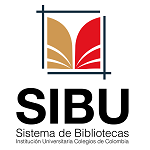SIBU - SISTEMAS DE BIBLIOTECAS UNICOC
Su carrito está vacío.
Escobar, Gloria Catalina
Capacidad de desinfección de la pasta triantibiotica en dientes permanentes inmaduros no vitales, en el tratamiento de revascularizacion: Reporte de caso clínico. Gloria Catalina Escobar, Diego Fernando Sanchez . - Bogotá (Colombia): Colegio Odontológico Colombiano - UNICOC; 2014.
Incluye referencias bibliográficas.
Tesis (Endodoncia) - Institución Colegios de Colombia - UNICOC.
RESUMEN
Propósito: El propósito de este reporte es presentar el caso de un central incisivo maxilar permanente inmaduro con necrosis pulpar y periodontitis apical asintomática tratado con un procedimiento de revascularización para inducir el cierre fisiológico del ápice radicular. Método: Se utilizó un incisivo central superior izquierdo (# 21), el cual fue desinfectado (no mecánicamente) con NaOCl al 5.25%; se realizaron dos cultivos microbiológicos durante el periodo de tratamiento (antes de la aplicación del medicamento intraconducto y del Mineral Trióxido Agregado). Se utilizó pasta triantibiótica (Minociclina 100 mg, Ciprofloxacina 500mg y Metronidazol 500 mg) como medicamento intraconducto para desinfectar el espacio pulpar por 21 días. En la siguiente cita, el diente fue inducido in vivo a través de la estimulación de sangrado desde el tejido periapical a través del canal y se obturo tercio coronal radicular con Mineral Trióxido agregado para promover el desarrollo radicular y el cierre del tercio apical. Conclusiones: El Staphylococcus spp demostró ser el microorganismo más resistente al procedimiento de desinfección. Se observó disminución de la lesión perirradicular y engrosamiento de las paredes dentinales radiculares por depósito de dentina. ABSTRACT
Purpose: The aim of this report is to present the case of a necrotic infected pulp space with asyntomatic apical periodontitis of an immature permanent maxillary central incisor treated with a revascularization procedure to induce the physiology closure of the apical root. Methodology: A maxillary central incisor (# 21) was used for the present report. The tooth was not mechanically cleaned during the treatment period with NaOCl 5.25%. Two microbial cultures were taken from the pulp space (before the place of the triantibiotic paste and the Mineral Trioxide Aggregate). Triantibiotic paste (Minocicline 100mg, Ciprofloxacine 500mg and Metronidazole 500mg) was used as intracanal medicament to disinfect the pulp space for 21 days. The follow up appointment, the tooth was induced in vivo by stimulation of a blood from the periapical tissues into the canal space and was placed mineral trioxide aggregate in order to seal and help to promote the root development and closure of the apical portion. Conclusions: Staphylococcus spp proved to be the most resistance in the disinfection procedure. Periradicular lesion size decreased with a thickthe root dentin walls were observed by deposit of dentin. Palabras Clave: Pasta Triantibiótica, Revascularización, Staphylococcus ; - Key words: Triantibiotic paste, Revascularization, Staphylococcus
Odontología / Endodoncia - Tesis y disertaciones academicas.
T.O.E. 0082
Capacidad de desinfección de la pasta triantibiotica en dientes permanentes inmaduros no vitales, en el tratamiento de revascularizacion: Reporte de caso clínico. Gloria Catalina Escobar, Diego Fernando Sanchez . - Bogotá (Colombia): Colegio Odontológico Colombiano - UNICOC; 2014.
Incluye referencias bibliográficas.
Tesis (Endodoncia) - Institución Colegios de Colombia - UNICOC.
RESUMEN
Propósito: El propósito de este reporte es presentar el caso de un central incisivo maxilar permanente inmaduro con necrosis pulpar y periodontitis apical asintomática tratado con un procedimiento de revascularización para inducir el cierre fisiológico del ápice radicular. Método: Se utilizó un incisivo central superior izquierdo (# 21), el cual fue desinfectado (no mecánicamente) con NaOCl al 5.25%; se realizaron dos cultivos microbiológicos durante el periodo de tratamiento (antes de la aplicación del medicamento intraconducto y del Mineral Trióxido Agregado). Se utilizó pasta triantibiótica (Minociclina 100 mg, Ciprofloxacina 500mg y Metronidazol 500 mg) como medicamento intraconducto para desinfectar el espacio pulpar por 21 días. En la siguiente cita, el diente fue inducido in vivo a través de la estimulación de sangrado desde el tejido periapical a través del canal y se obturo tercio coronal radicular con Mineral Trióxido agregado para promover el desarrollo radicular y el cierre del tercio apical. Conclusiones: El Staphylococcus spp demostró ser el microorganismo más resistente al procedimiento de desinfección. Se observó disminución de la lesión perirradicular y engrosamiento de las paredes dentinales radiculares por depósito de dentina. ABSTRACT
Purpose: The aim of this report is to present the case of a necrotic infected pulp space with asyntomatic apical periodontitis of an immature permanent maxillary central incisor treated with a revascularization procedure to induce the physiology closure of the apical root. Methodology: A maxillary central incisor (# 21) was used for the present report. The tooth was not mechanically cleaned during the treatment period with NaOCl 5.25%. Two microbial cultures were taken from the pulp space (before the place of the triantibiotic paste and the Mineral Trioxide Aggregate). Triantibiotic paste (Minocicline 100mg, Ciprofloxacine 500mg and Metronidazole 500mg) was used as intracanal medicament to disinfect the pulp space for 21 days. The follow up appointment, the tooth was induced in vivo by stimulation of a blood from the periapical tissues into the canal space and was placed mineral trioxide aggregate in order to seal and help to promote the root development and closure of the apical portion. Conclusions: Staphylococcus spp proved to be the most resistance in the disinfection procedure. Periradicular lesion size decreased with a thickthe root dentin walls were observed by deposit of dentin. Palabras Clave: Pasta Triantibiótica, Revascularización, Staphylococcus ; - Key words: Triantibiotic paste, Revascularization, Staphylococcus
Odontología / Endodoncia - Tesis y disertaciones academicas.
T.O.E. 0082
© 2014 UNICOC | Institución Universitaria Colegios de Colombia - UNICOC
Bogotá D.C. Autopista Norte Km. 20. Teléfono:(571)6683535
Cali: Calle 13 Norte No. 3N-13. Teléfono: (572)6608887
Idiomas:




